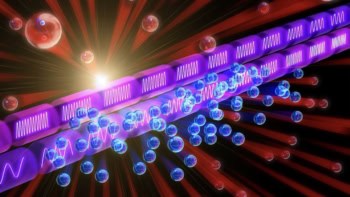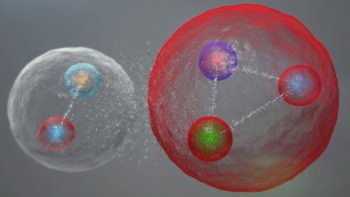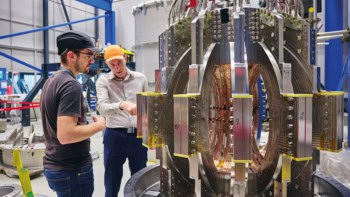
Physicists in Australia have produced further evidence that an excited state of the lambda baryon is a “subatomic molecule” – a meson and a nucleon that are bound together. While the physicists are not the first to suggest this exotic structure, they have done new computer simulations and calculations that they say “strongly suggest” that the lambda baryon can exist in this exotic configuration.
The lambda baryon (Λ) has no electrical charge and comprises three quarks (up, down and strange). Its discovery in 1950 by physicists at the University of Melbourne played an important role in the development of the quark model of matter and ultimately quantum chromodynamics (QCD), which is the theory of the strong interaction that binds quarks together in baryons and mesons.
Λ is a composite particle, and therefore it exists in a number of different energy states, much like an atom. Λ is the lowest-energy state and Λ(1405), which was discovered in 1961, is the lowest-lying excited state or resonance. As physicists developed the quark model in the 1960s, it became apparent that there was something not quite right about Λ(1405). In particular, the energy difference between Λ and Λ(1405) is much lower than expected, if Λ(1405) is assumed to be a “single particle” containing just three quarks.
Growing evidence
In the 1960s the Australian physicist Richard Dalitz and colleagues suggested that that Λ(1405) could comprise an anti-kaon meson bound to a nucleon (proton or neutron). This can occur in two ways: a negatively charged anti-kaon bound to a proton, or a neutral anti-kaon bound to a neutron. Working out the structure of Λ(1405) – or any baryon resonance for that matter – is extremely difficult because of the nonlinear nature of the strong interaction. However, over the past two decades theoretical support for molecular Λ(1405) has grown, with calculations done by several groups of physicists backing up the idea.
Now, Ross Young and colleagues at the University of Adelaide and the Australian National University have used lattice QCD to gain further insights into the nature of Λ(1405). The team used a lattice QCD simulation that was first developed by the Japan-based PACS-CS collaboration. The most important result of the team’s calculation is that the strange quark appears to make no contribution to the magnetic moment of Λ(1405). This is expected if the strange quark is confined within an anti-kaon with zero spin and is consistent with a molecular model of Λ(1405).
Energy levels
The team also analysed the energy levels calculated by lattice QCD and concluded that the Λ(1405) resonance is dominated by the anti-kaon nucleon molecule with a much smaller contribution from the single-particle three-quark state (up, down, strange).
José Antonio Oller of the University of Murcia in Spain calls the calculation of the strange quark’s magnetic contribution a “remarkable result”. However, he points out that while this zero magnetic contribution is a necessary condition for molecular Λ(1405), it is not sufficient to confirm the molecular nature of the resonance. He added that further calculations of the properties of Λ(1405) using other techniques are needed before the issue can be settled.
The calculations are described in Physical Review Letters.



